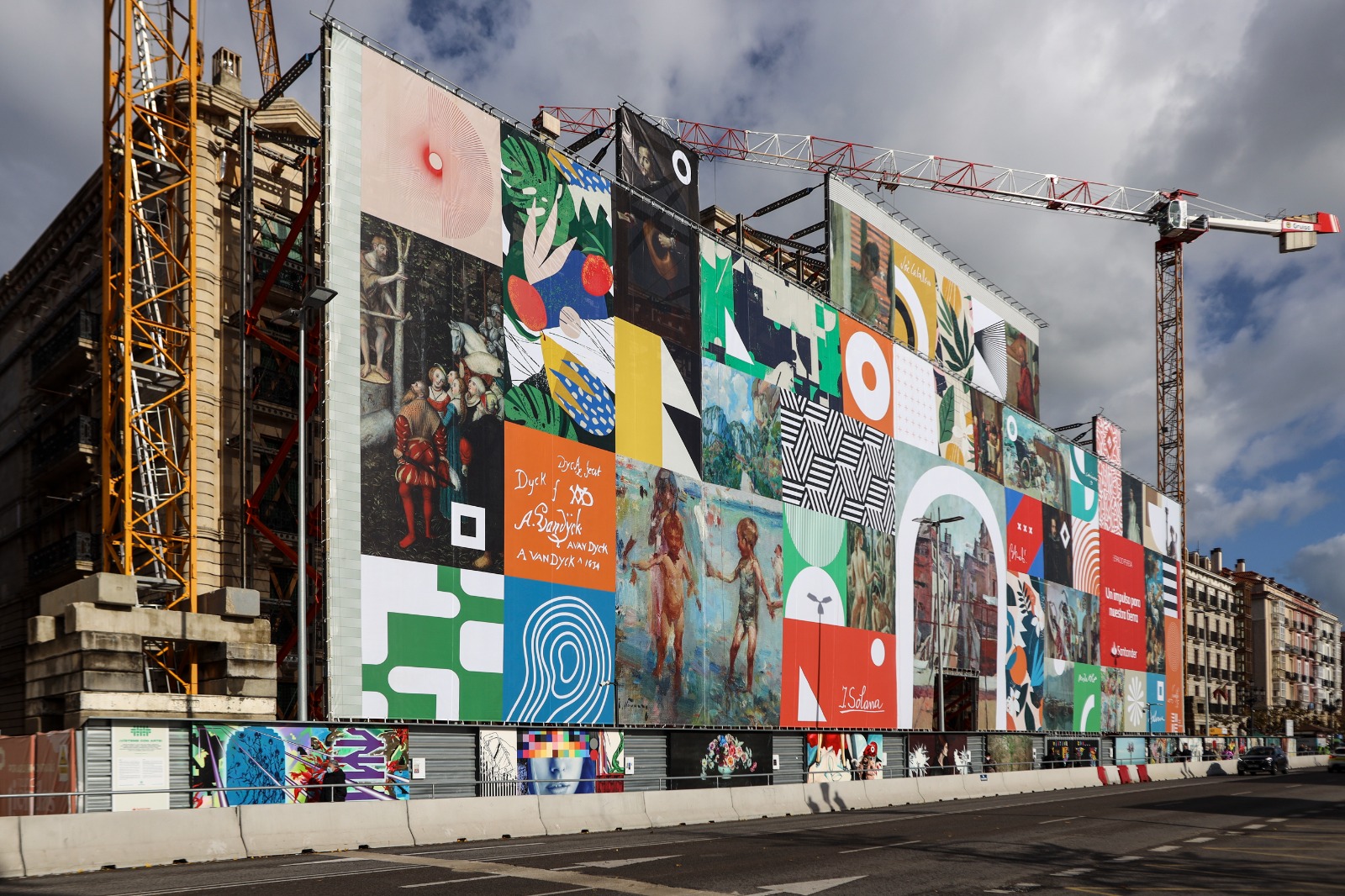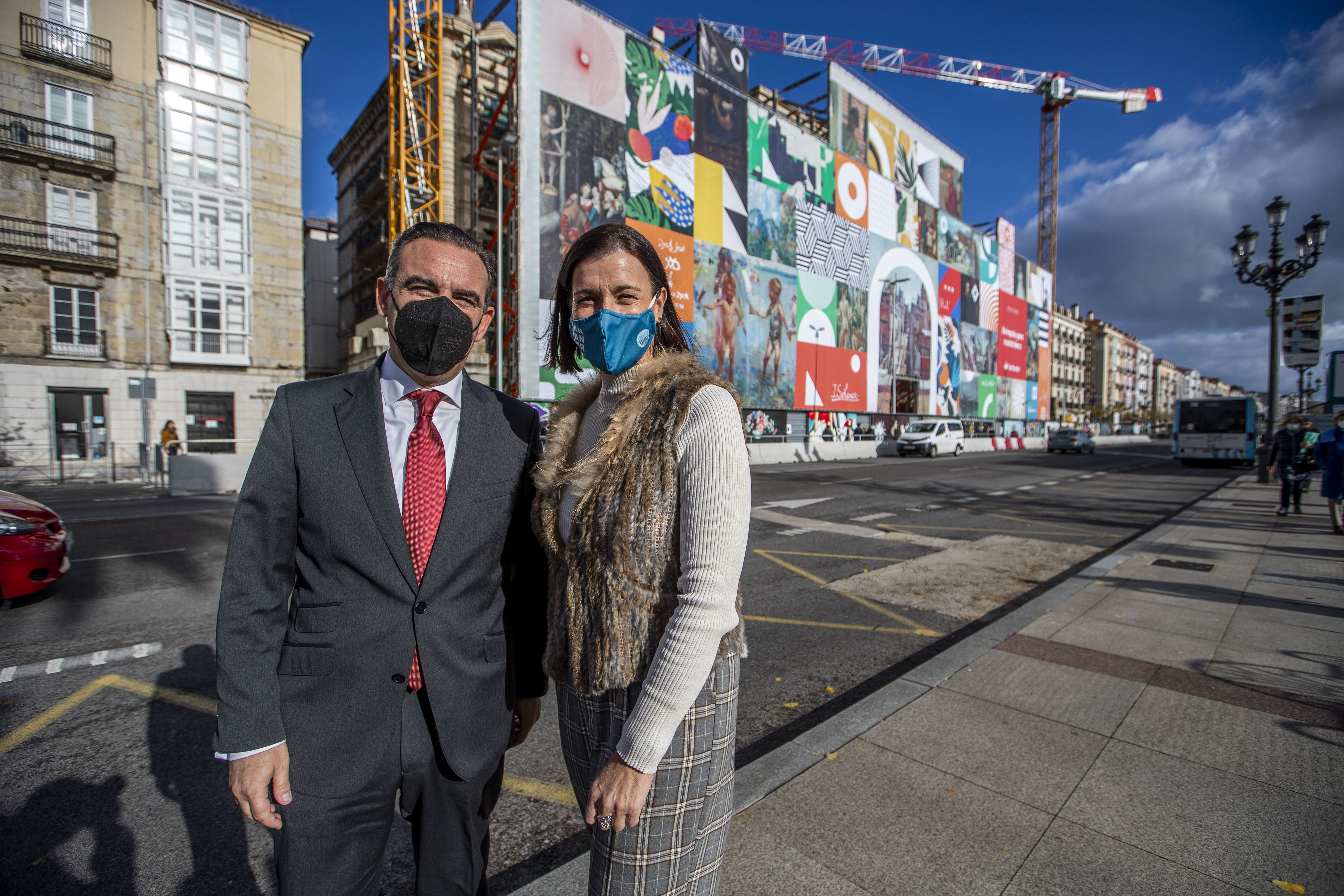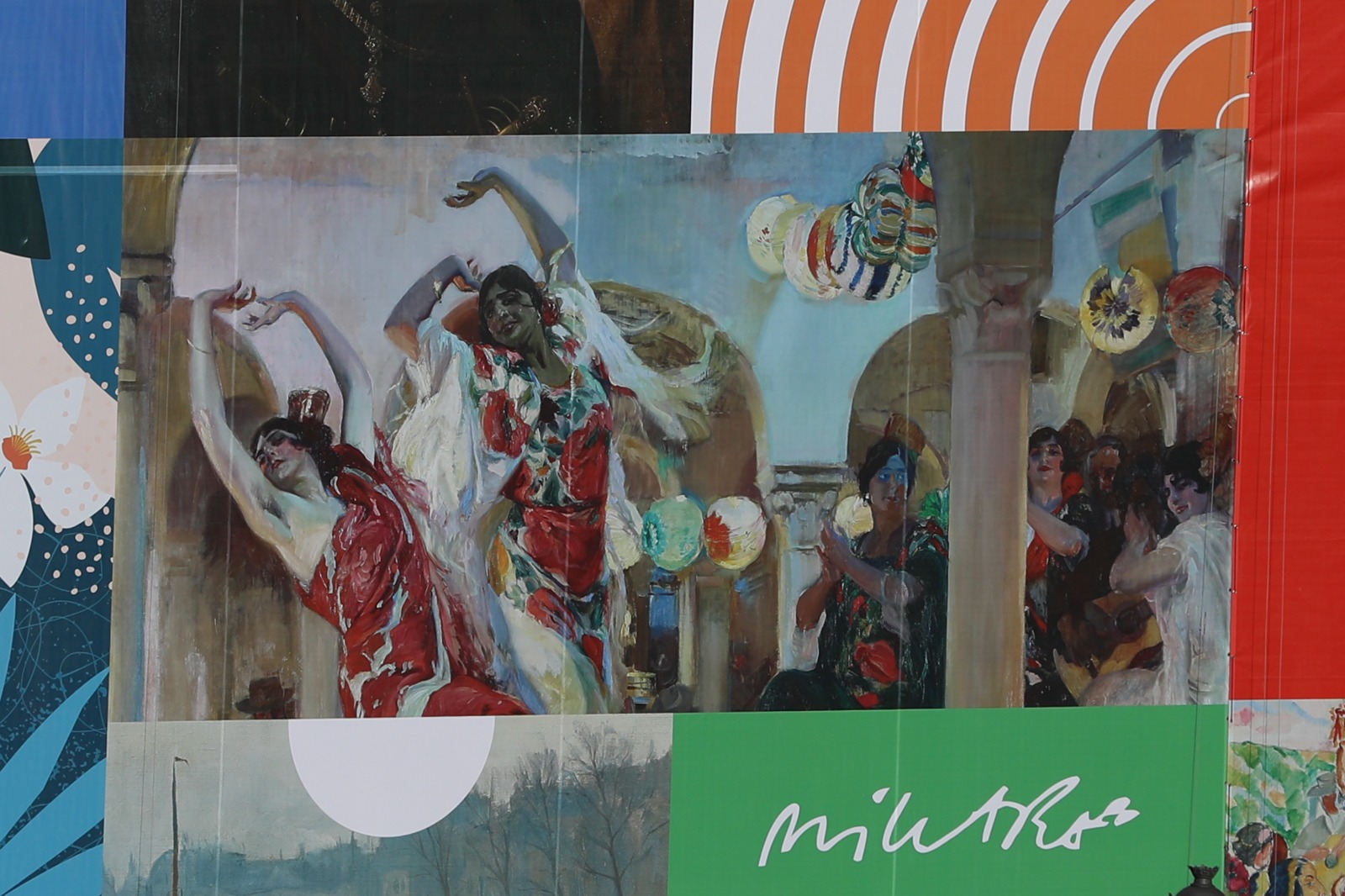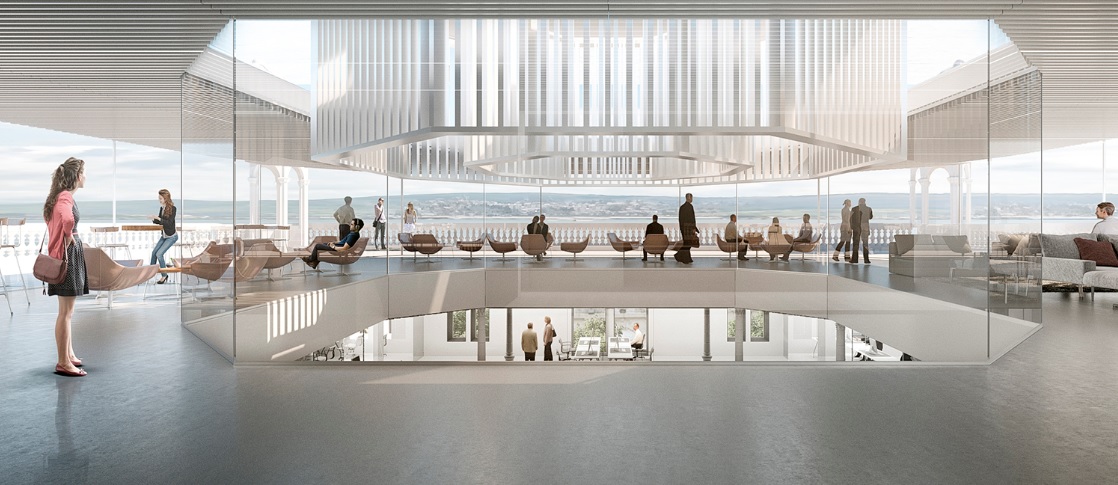Santander displays a canvas on the façade of the Espacio Pereda showing works in the Banco Santander Collection


The event was attended by Manuel Iturbe, Banco Santander’s regional head of Cantabria and Asturias, and Gema Igual, mayor of Santander.
Many of the works appearing on the canvas covering the façade will be displayed inside once the building is opened.
Santander, 2 December 2021.
Banco Santander, through the Banco Santander Foundation, has displayed a 1,375 square metre canvas on the main façade of Espacio Pereda, showing some of the most important paintings from the Banco Santander Collection. The Collection has been built up over more than 160 years by the various financial institutions that have been integrated into what is now Banco Santander.
It is one of the most important corporate collections, not only because of its historical value, but because many of its pieces deal with major issues of our time. These works are currently in the Art Gallery of Santander Group City, in Boadilla del Monte, Madrid, in an exhibition that brings together more than 200 works by recognised masters such as El Greco, Zurbarán, Sorolla, Picasso, Miró and Barceló. Together they constitute a unique journey through the history of art from the 16th century to the present.
This event follows on from the “Vísteme con arte” (Dress me artfully!) project, launched a few months ago, in which fourteen artists from, or linked to, the Cantabrian region converted the hoardings of the work on the southern façade into an open-air exhibition of contemporary art.
Manuel Iturbe, regional head of Banco Santander in Cantabria and Asturias, and Gema Igual, the mayor of the city, attended the installation of the canvas that will cover the main façade of Espacio Pereda during the execution of the work, until the containment and structural work on the building has been completed.
Gema Igual highlighted that “this new initiative of Banco Santander is another incentive for what will be Espacio Pereda and a decisive support for culture in the Cantabrian capital”. She thanked the institution for deciding to provide these cultural stimuli during the project. She described them as essential “to keep the expectations generated by the project alive and to invigorate Santander’s social and creative life”.
Manuel Iturbe stated: “We want the construction of Espacio Pereda to be accompanied by what will be its essence: support for culture. Hence, each phase of the project involves a cultural allusion, gradually revealing what Espacio Pereda will become in a few years’ time. A space in which we want to bring together culture and development, art and technology, which will be a meeting place for culture and young talent. In short, a space open to everyone.”



Details of the works of art appearing on the canvas
“Ceroferary Angels” (Anonymous, Burgos)
These are from the second half of the 15th century. Ceroferary or turiferary angels are the bearers of candles. They are represented in architecture accompanying the Virgin and the Child, both in altarpieces and in the tympana of the façades of the churches and cathedrals.
“The Sermon of Saint John the Baptist”, c. 1537/1540 (Lucas Cranach the Elder)
In this work, the improvised pulpit with the tree stump on which the Baptist preaches is most unusual. The audience of ten standing and listening, and the three knights in the background give the painting depth, forming a kind of funnel. The trees and the vegetation on the ground fill the space, their uniform green contrasting with the figures of the men and women who listen, attentive and thoughtful.
“The presentation of Jesus and the purification of Mary in the temple”, 1535/1545 (Anonymous, follower of Juan de Borgoña) and “Birth of Jesus and annunciation to the shepherds”, 1535/1545
These panels were found half a century ago in the Luzea tower house (Guipúzcoa) and classified as anonymous Castilian. The style is that of Juan de Borgoña (documented as living in Toledo from 1495 until his death); his influence is clear, although diluted, in the balanced layout of the figures and in the architectural background, including the paving. There is a third panel (Adoration of the Magi). They all have almost the same measurements and, since they belong to the cycle of the childhood of Jesus, likely formed part of the same altarpiece.
“Don Diego de Mexía, Marquess of Leganés”, c. 1630. Van Dyck, (1599-1641)
The portrait of the Marquess of Leganés belongs to a time when van Dyck was one of the most sought-after portrait painters in Antwerp. It is a full-length painting of the Spanish politician, with a wealth of symbolic elements alluding to his status as a courtier and soldier, such as his sword, the scallop of a Knight of Santiago, the key showing he was a King's gentleman and the desk.
The Marquess of Leganés was one of the great collectors of the period. It appears that his collection contained around 1,300 works, including Spanish artists such as Velázquez, Ribera, Sánchez Coello and El Greco.
“The Messenger”, c.1640. Friar Juan Ricci (1600-1681)
Juan Andrés Ricci has been seen as the “Castilian Zurbarán” because of the sobriety and serenity that flow through his work, and because of the silence and naturalism of his painting. The messenger’s gesture and friendly attitude, bending forward with a letter in one hand and his hat in the other, as though bowing, can be related to those of General Spínola in Velázquez’s “The Surrender of Breda” and are also present in other meetings such as Rubens’ “Meeting of King Ferdinand of Hungary and the Cardinal-Infante Ferdinand of Spain at Nördlingen”.
“Asia” (Series of the Four Parts of the World), 1687. Luca Giordano
This work is part of a set of four old copies of the Giordano series sent to the Alcázar de Madrid in around 1687-1689, before the painter's arrival in Spain. Asia is represented by a young woman with a floral crown, accompanied by men in various costumes and turbans, a camel and many children who are lighting braziers. In the background rides a classical horseman, undoubtedly Alexander the Great, the first explorer of Asia.
“Carrer de la Noguera seen from Carrer de Balmes”, 1927. Francesc Gimeno (1858-1927)
This is a work that fully retains the painter’s usual strength and freshness, despite belonging to the last months of his life, a stage in which many artists’ work becomes clearly mannered. This is an engaging subject in Gimeno’s work, as it reflects the street of the former village of Sant Gervasi de Cassoles, in which the painter lived and died, a street today named after the painter.
“Boats on the Seine”, circa 1894. Santiago Rusiñol (1861-1931)
This is an excellent work from one of the fundamental periods of Rusiñol’s painting career: a clear example of his typical grey and measured impressionism.
“Women dancing flamenco at the café Novedades in Seville”, 1914. Joaquín Sorolla (1863-1923)
In 1900 Sorolla won the Grand Prix of the Paris Universal Exposition and in 1901 the medal of honour of the National Exhibition of Madrid. From then on, his successes would be numerous and he would have individual exhibitions in Paris, Berlin, Düsseldorf, Cologne, London, New York, Buffalo, Boston, Chicago and St Louis. Reflecting these successes, in 1913 the American magnate and collector, Thomas F. Ryan, commissioned two paintings from him, one of which was “Women dancing flamenco at the café Novedades in Seville”.
“Manolas”, c. 1910. Francisco Iturrino (1864-1924)
An excellent composition from the series of groups of manolas (working-class women) that Iturrino often painted during the first decade of the 20th century. It would be around the time that Iturrino and Matisse were painting together in Andalusia. It is an oil painting in pure colours and apparently spontaneous brush strokes, very closely related to the fauvism of the time.
“Montserrat Casas”, 1888 and “Woman against a blind”, circa 1890, Ramón Casas (1866-1932)
The picture of Montserrat Casas, the artist’s elder sister, is a full-length canvas with loose brush strokes, already showing signs of a timid impressionist influence that would still take a couple of years to appear fully in his painting.
The small work “Woman against a blind” was painted during a stay in Montmartre; here, what stands out is the ‘photographic’ concept and the preference for blurred, schematic lines.
“Horse-drawn Carriage and Child on the Beach”, c. 1908 and “Children on the beach”, c. 1908. José Navarro Llorens (1867-1923)
These works are characteristic of this skilled, meticulous Valencian painter. A self-taught loner, he did not usually present his work to competitions or exhibitions but, through dealers, he found a notable international market. The popular flavour of his subjects and the search for brightness, often accentuated by the skilful use of light reflected on the skin of his human forms, characterise his style and appear time and again in his many works.
“The Acolytes' Garden. Montserrat”, c. 1931. Joaquim Mir (1873-1940)
A work characteristic of the painter’s full maturity, with a luminous realism and an agile, fluid dominance of the oil technique, far removed from symbolist echoes.
This oil painting already corresponds to the painter’s second stay in Montserrat (1931). With this work, Mir is no longer the naïve visionary bursting with new plastic ideas, but the peaceful family man who has found an honourable, unhurried path combining professionalism and craft.
“Girls bathing”, c.1930-35. Aurelio Arteta (1879-1940)
A composition typical of the mature Arteta, increasingly simplifying his compositions, which already tended towards the schematic. The result is the creation of a sober archetypical scene of nudes, with a constructivism now released from all rigidity, very similar in theme, spirit and execution to “Bathers” by the same painter, which won him the 1930 National Painting Award.












